Blog
Falls Prevention Tips for Seniors at Home
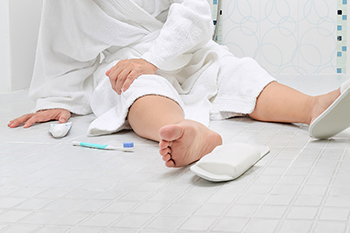
Helping seniors stay safe at home begins with simple changes that reduce everyday risks. Keeping commonly used items within easy reach prevents the need for stretching or climbing. Replacing dim bulbs and using night lights improves visibility and reduces the chance of tripping in low light areas. Installing grab bars in bathrooms and hallways provides extra support and confidence. Choosing rugs with non-slip backing keeps floors secure and prevents sliding. A podiatrist can assess balance concerns, identify foot or ankle issues, recommend proper footwear, and create strategies to enhance stability. If you have sustained a foot or ankle injury from falling at home, it is suggested that you contact a podiatrist who can treat these kinds of injuries, and guide you on additional fall prevention strategies.
Preventing falls among the elderly is very important. If you are older and have fallen or fear that you are prone to falling, consult with Jack A. Sasiene, DPM from Texas. Our doctor will assess your condition and provide you with quality advice and care.
Every 11 seconds, an elderly American is being treated in an emergency room for a fall related injury. Falls are the leading cause of head and hip injuries for those 65 and older. Due to decreases in strength, balance, senses, and lack of awareness, elderly persons are very susceptible to falling. Thankfully, there are a number of things older persons can do to prevent falls.
How to Prevent Falls
Some effective methods that older persons can do to prevent falls include:
- Enrolling in strength and balance exercise program to increase balance and strength
- Periodically having your sight and hearing checked
- Discuss any medications you have with a doctor to see if it increases the risk of falling
- Clearing the house of falling hazards and installing devices like grab bars and railings
- Utilizing a walker or cane
- Wearing shoes that provide good support and cushioning
- Talking to family members about falling and increasing awareness
Falling can be a traumatic and embarrassing experience for elderly persons; this can make them less willing to leave the house, and less willing to talk to someone about their fears of falling. Doing such things, however, will increase the likelihood of tripping or losing one’s balance. Knowing the causes of falling and how to prevent them is the best way to mitigate the risk of serious injury.
If you have any questions, please feel free to contact our offices located in Texas City and Lake Jackson, TX . We offer the newest diagnostic and treatment technologies for all your foot care needs.
Foot Cramps and Their Causes
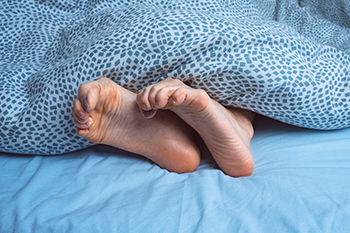
Foot cramps are sudden, involuntary muscle contractions that cause sharp pain and stiffness in the foot. They may occur during activity or even while resting. Common causes include dehydration, electrolyte imbalance, poor circulation, or overuse of muscles. Risk factors include intense exercise without proper stretching, wearing footwear lacking adequate support, and medical conditions that affect nerves or blood flow. These cramps can interfere with daily activities and athletic performance, if not addressed. A podiatrist can identify underlying causes, recommend stretching and strengthening exercises, and provide guidance on footwear or orthotics to reduce recurrence. Foot cramps can disrupt daily activities as well as sleep. If this applies to you, it is suggested that you schedule an appointment with a podiatrist who can diagnose the cause, and offer effective relief and treatment solutions.
Foot Pain
Foot pain can be extremely painful and debilitating. If you have a foot pain, consult with Jack A. Sasiene, DPM from Texas. Our doctor will assess your condition and provide you with quality foot and ankle treatment.
Causes
Foot pain is a very broad condition that could be caused by one or more ailments. The most common include:
- Bunions
- Hammertoes
- Plantar Fasciitis
- Bone Spurs
- Corns
- Tarsal Tunnel Syndrome
- Ingrown Toenails
- Arthritis (such as Gout, Rheumatoid, and Osteoarthritis)
- Flat Feet
- Injury (from stress fractures, broken toe, foot, ankle, Achilles tendon ruptures, and sprains)
- And more
Diagnosis
To figure out the cause of foot pain, podiatrists utilize several different methods. This can range from simple visual inspections and sensation tests to X-rays and MRI scans. Prior medical history, family medical history, and any recent physical traumatic events will all be taken into consideration for a proper diagnosis.
Treatment
Treatment depends upon the cause of the foot pain. Whether it is resting, staying off the foot, or having surgery; podiatrists have a number of treatment options available for foot pain.
If you have any questions, please feel free to contact our offices located in Texas City and Lake Jackson, TX . We offer the newest diagnostic and treatment technologies for all your foot care needs.
How Pregnancy Can Affect the Feet
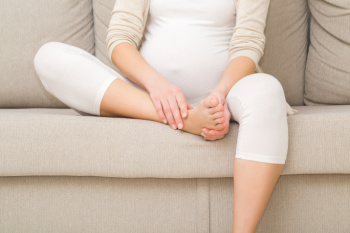
Pregnancy can have a significant impact on the feet, ankles, and toes due to both physical and hormonal changes. As body weight increases, the added pressure shifts the center of gravity forward, placing extra strain on the feet and ankles. This can cause discomfort and contribute to swelling, often making it difficult to find properly fitting shoes. In the later stages of pregnancy, the hormone relaxin causes ligaments in the feet to loosen, which may lead to flattening of the arches, lengthening of the feet, and broadening of the forefoot. These structural changes can sometimes remain permanent, leading to ongoing issues like pain or difficulty with balance. Reduced physical activity and swelling can further aggravate foot fatigue, particularly in the third trimester. A podiatrist can assess these changes, address sources of discomfort, and provide treatment to help improve foot health. If you are experiencing foot problems during pregnancy, it is suggested that you schedule an appointment with a podiatrist to help increase comfort and mobility.
Pregnant women with swollen feet can be treated with a variety of different methods that are readily available. For more information about other cures for swollen feet during pregnancy, consult with Jack A. Sasiene, DPM from Texas. Our doctor will attend to all of your foot and ankle needs.
What Foot Problems Can Arise During Pregnancy?
One problem that can occur is overpronation, which occurs when the arch of the foot flattens and tends to roll inward. This can cause pain and discomfort in your heels while you’re walking or even just standing up, trying to support your baby.
Another problem is edema, or swelling in the extremities. This often affects the feet during pregnancy but tends to occur in the later stages.
How Can I Keep My Feet Healthy During Pregnancy?
- Wearing orthotics can provide extra support for the feet and help distribute weight evenly
- Minimize the amount of time spent walking barefoot
- Wear shoes with good arch support
- Wear shoes that allow for good circulation to the feet
- Elevate feet if you experience swelling
- Massage your feet
- Get regular, light exercise, such as walking, to promote blood circulation to the feet
If you have any questions, please feel free to contact our offices located in Texas City and Lake Jackson, TX . We offer the newest diagnostic and treatment technologies for all your foot care needs.
Body Mass Index and Your Feet
 Being obese, or having a BMI (Body Mass Index) of 30 or higher, can cause serious, negative effects throughout your body, including your feet, which absorb the force of your body weight. People with a higher BMI put an increased amount of foot pressure under the heel and metatarsal heads (balls of the foot) which is where you push off to walk or run. Obesity can also change the structure of your feet, causing them to widen, putting excess strain on your ankles, and overburdening your arches. Common foot problems that cause pain and discomfort in obese individuals include plantar fasciitis, bunions, and hammertoe. Trying to reduce your body mass is a good step towards improving your overall health. Contacting a podiatrist is another good step to take to treat any pain or discomfort you may be experiencing in your feet or ankles.
Being obese, or having a BMI (Body Mass Index) of 30 or higher, can cause serious, negative effects throughout your body, including your feet, which absorb the force of your body weight. People with a higher BMI put an increased amount of foot pressure under the heel and metatarsal heads (balls of the foot) which is where you push off to walk or run. Obesity can also change the structure of your feet, causing them to widen, putting excess strain on your ankles, and overburdening your arches. Common foot problems that cause pain and discomfort in obese individuals include plantar fasciitis, bunions, and hammertoe. Trying to reduce your body mass is a good step towards improving your overall health. Contacting a podiatrist is another good step to take to treat any pain or discomfort you may be experiencing in your feet or ankles.
Obesity has become very problematic at this point in time and can have extremely negative effects on the feet. If you’re an obese individual and are concerned about your feet, contact Jack A. Sasiene, DPM from Texas. Our doctor can provide the care you need to keep you pain-free and on your feet.
Obesity and Your Feet
Since your feet are what support your entire weight when standing, any additional weight can result in pain and swelling. Being overweight is one of the main contributors to foot complications.
Problems & Complications
Extra Weight – Even putting on just a few extra pounds could create serious complications for your feet. As your weight increases, your balance and body will shift, creating new stresses on your feet. This uneven weight distribution can cause pain, even while doing the simplest tasks, such as walking.
Diabetes – People who are overweight are at serious risk of developing type-2 diabetes, which has a drastic impact on the health of your feet. As you get older, your diabetes might worsen, which could lead to loss of feeling in your feet, sores, and bruises. You could also become more prone to various infections.
Plantar fasciitis – Pressure and stress that is placed on muscles, joints, and tendons can trigger plantar fasciitis, which is an inflammation of tissue that forms along the bottom of the foot.
If you have any questions, please feel free to contact our offices located in Texas City and Lake Jackson, TX . We offer the newest diagnostic and treatment technologies for all your foot care needs.
Gout Pain Can Be Managed
Calcaneal Osteomyelitis From a Puncture Wound
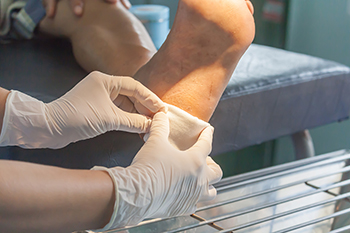
Calcaneal osteomyelitis is a serious bone infection in the heel that can develop after a puncture wound to the foot. When bacteria enter through a deep wound, they can reach the bone and cause inflammation, pain, swelling, and difficulty walking. Early care is vital to prevent serious complications. Cleaning the wound thoroughly, avoiding pressure on the heel, and seeking prompt medical attention from a podiatrist can reduce the risk of infection. This foot doctor can diagnose the condition through imaging tests and provide treatment that may include antibiotics, wound care, and surgical management, if necessary. If you have sustained a puncture wound on your foot, it is suggested that you schedule an appointment with a podiatrist who can provide an examination and offer appropriate treatment.
Wound care is an important part in dealing with diabetes. If you have diabetes and a foot wound or would like more information about wound care for diabetics, consult with Jack A. Sasiene, DPM from Texas. Our doctor will assess your condition and provide you with quality foot and ankle treatment.
What Is Wound Care?
Wound care is the practice of taking proper care of a wound. This can range from the smallest to the largest of wounds. While everyone can benefit from proper wound care, it is much more important for diabetics. Diabetics often suffer from poor blood circulation which causes wounds to heal much slower than they would in a non-diabetic.
What Is the Importance of Wound Care?
While it may not seem apparent with small ulcers on the foot, for diabetics, any size ulcer can become infected. Diabetics often also suffer from neuropathy, or nerve loss. This means they might not even feel when they have an ulcer on their foot. If the wound becomes severely infected, amputation may be necessary. Therefore, it is of the upmost importance to properly care for any and all foot wounds.
How to Care for Wounds
The best way to care for foot wounds is to prevent them. For diabetics, this means daily inspections of the feet for any signs of abnormalities or ulcers. It is also recommended to see a podiatrist several times a year for a foot inspection. If you do have an ulcer, run the wound under water to clear dirt from the wound; then apply antibiotic ointment to the wound and cover with a bandage. Bandages should be changed daily and keeping pressure off the wound is smart. It is advised to see a podiatrist, who can keep an eye on it.
If you have any questions please contact our offices located in Texas City and Lake Jackson, TX . We offer the newest diagnostic and treatment technologies for all your foot and ankle needs.
What Is Freiberg’s Disease?
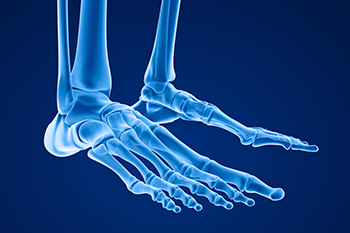
Freiberg’s disease is a painful foot condition that affects the metatarsal bones, most often the second metatarsal located near the base of the toes. It occurs when the blood supply to the bone is disrupted, leading to tissue damage and collapse of the bone surface. Causes may include repetitive stress, trauma, or genetic predisposition, and it most often develops in adolescents and young adults. Symptoms include pain in the ball of the foot, swelling, stiffness, and difficulty bearing weight or wearing shoes comfortably. A podiatrist can help by diagnosing the condition, providing orthotics, recommending activity modifications, or discussing surgical options in severe cases. If you have persistent foot pain, it is suggested that you promptly consult a podiatrist who can accurately diagnose the problem and offer effective relief and management solutions.
Some foot conditions may require additional professional care. If you have any concerns, contact Jack A. Sasiene, DPM of Texas. Our doctor can provide the care you need to keep you pain-free and on your feet.
Rare Foot Conditions
The majority of foot conditions are common and can be treated by a podiatrist. Standard diagnostic procedures are generally used to identify specific conditions and treatment can be rendered. A podiatrist also treats rare foot conditions which can be difficult to diagnose and may need extra attention and care.
There are many rare foot conditions that can affect children. Some of these can include:
- Freiberg’s disease
- Kohler’s disease
- Maffucci syndrome
Freiberg’s disease - This can be seen as a deterioration and flattening of a metatarsal bone that exists in the ball of the foot. It typically affects pre-teen and teenage girls, but can affect anyone at any age. Symptoms that can accompany this can be swelling, stiffness, and the patient may limp.
Kohler’s disease - This often targets the bone in the arch of the foot and affects younger boys. It can lead to an interruption of the blood supply which ultimately can lead to bone deterioration. The patient may limp or experience tenderness, swelling, and redness.
Maffucci syndrome - This affects the long bones in a child’s foot leading to the development of abnormal bone lesions. They are benign growths and typically develop in early childhood and the bones may be susceptible to breaking.
A podiatrist can properly diagnose and treat all types of rare foot conditions. If your child is affected by any of these symptoms or conditions, please don’t hesitate to call our office so the correct treatment method can begin.
If you have any questions, please feel free to contact our offices located in Texas City and Lake Jackson, TX . We offer the newest diagnostic and treatment technologies for all your foot care needs.
Looking After a Broken Foot
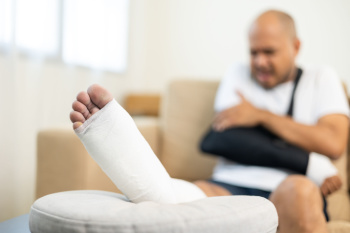
A fracture in the foot can result from a sudden injury, an awkward step, or repeated stress on the bones. Signs may include sharp pain, swelling, bruising, or trouble standing and walking. Because the foot has many small bones that work together for balance and movement, getting the right care is essential. Treatment varies depending on how serious the break is. Some patients may need only rest, a walking boot, or crutches, while others may require a cast, or, in more complicated cases, surgery to realign the bones. Elevating the foot and keeping weight off it helps with recovery. Healing usually takes several weeks, but following a podiatrist’s guidance supports a smoother return to activity. If you think you may have fractured your foot, it is recommended that you promptly visit a podiatrist for an accurate diagnosis and care plan.
A broken foot requires immediate medical attention and treatment. If you need your feet checked, contact Jack A. Sasiene, DPM from Texas. Our doctor can provide the care you need to keep you pain-free and on your feet.
Broken Foot Causes, Symptoms, and Treatment
A broken foot is caused by one of the bones in the foot typically breaking when bended, crushed, or stretched beyond its natural capabilities. Usually the location of the fracture indicates how the break occurred, whether it was through an object, fall, or any other type of injury.
Common Symptoms of Broken Feet:
- Bruising
- Pain
- Redness
- Swelling
- Blue in color
- Numbness
- Cold
- Misshapen
- Cuts
- Deformities
Those that suspect they have a broken foot shoot seek urgent medical attention where a medical professional could diagnose the severity.
Treatment for broken bones varies depending on the cause, severity and location. Some will require the use of splints, casts or crutches while others could even involve surgery to repair the broken bones. Personal care includes the use of ice and keeping the foot stabilized and elevated.
If you have any questions, please feel free to contact our offices located in Texas City and Lake Jackson, TX . We offer the newest diagnostic and treatment technologies for all your foot care needs.
Causes and Care for Pain on the Top of the Foot
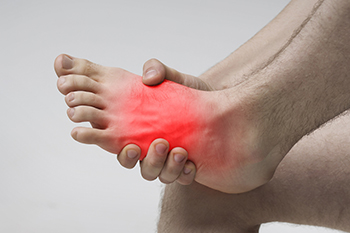
Pain on the top of the foot can result from several conditions. One common cause is wearing shoes that are too tight across the laces, which can irritate nerves and tendons. Overuse injuries, such as tendonitis or stress fractures, also frequently affect this area, especially in athletes and runners. Arthritis, ganglion cysts, and nerve entrapment may also lead to discomfort on the top of the foot. Identifying the exact source of pain is important in order to guide treatment. Rest, wearing supportive footwear, and anti-inflammatory measures may help relieve mild symptoms. Custom orthotics, bracing, or targeted exercises can provide additional support when needed. In more severe cases, surgery may be required. If you are dealing with ongoing pain on the top of your foot, it is suggested that you schedule an appointment with a podiatrist for an accurate diagnosis and individualized treatment plan.
Foot Pain
Foot pain can be extremely painful and debilitating. If you have a foot pain, consult with Jack A. Sasiene, DPM from Texas. Our doctor will assess your condition and provide you with quality foot and ankle treatment.
Causes
Foot pain is a very broad condition that could be caused by one or more ailments. The most common include:
- Bunions
- Hammertoes
- Plantar Fasciitis
- Bone Spurs
- Corns
- Tarsal Tunnel Syndrome
- Ingrown Toenails
- Arthritis (such as Gout, Rheumatoid, and Osteoarthritis)
- Flat Feet
- Injury (from stress fractures, broken toe, foot, ankle, Achilles tendon ruptures, and sprains)
- And more
Diagnosis
To figure out the cause of foot pain, podiatrists utilize several different methods. This can range from simple visual inspections and sensation tests to X-rays and MRI scans. Prior medical history, family medical history, and any recent physical traumatic events will all be taken into consideration for a proper diagnosis.
Treatment
Treatment depends upon the cause of the foot pain. Whether it is resting, staying off the foot, or having surgery; podiatrists have a number of treatment options available for foot pain.
If you have any questions, please feel free to contact our offices located in Texas City and Lake Jackson, TX . We offer the newest diagnostic and treatment technologies for all your foot care needs.
Are Bunions Affecting Your Everyday Life?
More...
When Toenails Become Infected by Fungus

Onychomycosis, also called tinea unguium, is a fungal infection that affects the toenails. It often begins as a small white or yellow spot under the nail and gradually spreads, causing the nail to thicken, change color, and become brittle. Over time, the nail may crumble, separate from the nail bed, or cause discomfort when walking or wearing shoes. Several factors raise the risk of developing this condition. Warm, moist environments, such as locker rooms and around public pools, encourage fungal growth. Wearing tight shoes, having diabetes, reduced circulation, or a weakened immune system also makes infection more likely. Because toenail fungus rarely clears on its own, professional treatment is important. Options may include oral or topical antifungal medications or removal of severely damaged nails. If you notice changes in your toenails that suggest infection, it is suggested that you see a podiatrist for a diagnosis and appropriate treatment.
If left untreated, toenail fungus may spread to other toenails, skin, or even fingernails. If you suspect you have toenail fungus it is important to seek treatment right away. For more information about treatment, contact Jack A. Sasiene, DPM of Texas. Our doctor can provide the care you need to keep you pain-free and on your feet.
Symptoms
- Warped or oddly shaped nails
- Yellowish nails
- Loose/separated nail
- Buildup of bits and pieces of nail fragments under the nail
- Brittle, broken, thickened nail
Treatment
If self-care strategies and over-the-counter medications does not help your fungus, your podiatrist may give you a prescription drug instead. Even if you find relief from your toenail fungus symptoms, you may experience a repeat infection in the future.
Prevention
In order to prevent getting toenail fungus in the future, you should always make sure to wash your feet with soap and water. After washing, it is important to dry your feet thoroughly especially in between the toes. When trimming your toenails, be sure to trim straight across instead of in a rounded shape. It is crucial not to cover up discolored nails with nail polish because that will prevent your nail from being able to “breathe”.
In some cases, surgical procedure may be needed to remove the toenail fungus. Consult with your podiatrist about the best treatment options for your case of toenail fungus.
If you have any questions please contact our offices located in Texas City and Lake Jackson, TX . We offer the newest diagnostic and treatment technologies for all your foot and ankle needs.
The Importance of Shoes That Fit Properly
 Properly fitting shoes have a larger impact on foot health than many people realize. The shape and size of your foot change over time because ligaments and soft tissues relax and stretch as you age. Having foot measurements done annually or even twice a year can help you keep track of the right shoe size for you. Making sure your toes can move freely inside your shoe is important. If your toes don’t have enough room, this could lead to corns, calluses, or deformed toes. Ill-fitting shoes can also cause complications such as bunions, Morton’s neuroma, or plantar fasciitis. Wearing high heels also increases the risk of painful foot conditions because of the pressure that is put on the forefoot. If you would like to learn more about how to find your proper shoe size, it is suggested you consult with a podiatrist.
Properly fitting shoes have a larger impact on foot health than many people realize. The shape and size of your foot change over time because ligaments and soft tissues relax and stretch as you age. Having foot measurements done annually or even twice a year can help you keep track of the right shoe size for you. Making sure your toes can move freely inside your shoe is important. If your toes don’t have enough room, this could lead to corns, calluses, or deformed toes. Ill-fitting shoes can also cause complications such as bunions, Morton’s neuroma, or plantar fasciitis. Wearing high heels also increases the risk of painful foot conditions because of the pressure that is put on the forefoot. If you would like to learn more about how to find your proper shoe size, it is suggested you consult with a podiatrist.
Getting the right shoe size is an important part of proper foot health. Seek the assistance of Jack A. Sasiene, DPM from Texas. Our doctor will provide the care you need to keep you pain-free and on your feet.
Getting the Right Shoe Size
There are many people who wear shoes that are the incorrect size, negatively affecting their feet and posture. Selecting the right shoes is not a difficult process, so long as you keep several things in mind when it comes to choosing the right pair.
- When visiting the shoe store, use the tools available to measure your foot.
- Be sure there is ‘wiggle room’. There should be about an inch between your toes and the tip of your shoes.
- Do not always assume you are the same size, as manufacturers run differently.
- Purchase shoes later in the day, as your feet swell as the day progresses.
- If a shoe is not comfortable, it is not suitable. Most shoes can’t be ‘broken in’, and comfort should be the ultimate goal when it comes to choosing the right pair of shoes
As our feet hold our body weight and keep us moving, it is important to treat them right. Picking the right pair of shoes can provide your feet comfort and mobility without pain.
If you have any questions, please feel free to contact our offices located in Texas City and Lake Jackson, TX . We offer the newest diagnostic and treatment technologies for all your foot care needs.
Gout and Ways to Manage It
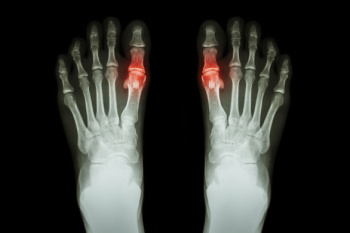
Gout is a form of arthritis that occurs when uric acid builds up in the body, forming crystals in the joints, most commonly affecting the big toe. It can cause sudden, intense pain, swelling, redness, and warmth in the affected area, often making walking or standing difficult. Causes include high purine foods, excessive alcohol consumption, obesity, and certain medications. Risk factors involve family history, age, and chronic health conditions such as kidney disease. A podiatrist can help diagnose gout, provide treatments to relieve pain and inflammation, and recommend lifestyle modifications to reduce flare ups. If you have pain in your big toe, it is suggested that you consult a podiatrist who can accurately diagnose gout, and offer effective relief and management tips.
Gout is a painful condition that can be treated. If you are seeking treatment, contact Jack A. Sasiene, DPM from Texas. Our doctor will treat your foot and ankle needs.
What Is Gout?
Gout is a form of arthritis that is characterized by sudden, severe attacks of pain, redness, and tenderness in the joints. The condition usually affects the joint at the base of the big toe. A gout attack can occur at any random time, such as the middle of the night while you are asleep.
Symptoms
- Intense Joint Pain - Usually around the large joint of your big toe, and it most severe within the first four to twelve hours
- Lingering Discomfort - Joint discomfort may last from a few days to a few weeks
- Inflammation and Redness -Affected joints may become swollen, tender, warm and red
- Limited Range of Motion - May experience a decrease in joint mobility
Risk Factors
- Genetics - If family members have gout, you’re more likely to have it
- Medications - Diuretic medications can raise uric acid levels
- Gender/Age - Gout is more common in men until the age of 60. It is believed that estrogen protects women until that point
- Diet - Eating red meat and shellfish increases your risk
- Alcohol - Having more than two alcoholic drinks per day increases your risk
- Obesity - Obese people are at a higher risk for gout
Prior to visiting your podiatrist to receive treatment for gout, there are a few things you should do beforehand. If you have gout you should write down your symptoms--including when they started and how often you experience them, important medical information you may have, and any questions you may have. Writing down these three things will help your podiatrist in assessing your specific situation so that he or she may provide the best route of treatment for you.
If you have any questions, please feel free to contact our offices located in Texas City and Lake Jackson, TX . We offer the newest diagnostic and treatment technologies for all your foot care needs.
When the Big Toe Stops Bending
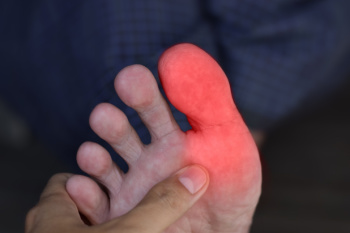
Hallux rigidus is a form of arthritis that affects the big toe joint, making it stiff and painful. The condition often begins with mild discomfort when walking or bending the toe, but over time the joint loses flexibility. People may notice swelling, difficulty wearing certain shoes, or pain that worsens with activity. In advanced cases, even standing can become uncomfortable as the joint becomes increasingly rigid. This problem usually develops from wear and tear on the joint, past injuries, or inherited foot structure. Because the big toe plays a key role in movement, hallux rigidus can significantly affect mobility and daily comfort. Early treatment may include anti-inflammatory medication, shoe modifications, or custom orthotics to ease pressure. If the joint damage is more severe, surgery may be considered. If you have pain in your big toe joint, it is suggested that you see a podiatrist to ensure the condition is managed properly, mobility preserved, and pain reduced.
Arthritis can be a difficult condition to live with. If you are seeking treatment, contact Jack A. Sasiene, DPM from Texas. Our doctor can provide the care you need to keep you pain-free and on your feet.
Arthritic Foot Care
Arthritis is a term that is commonly used to describe joint pain. The condition itself can occur to anyone of any age, race, or gender, and there are over 100 types of it. Nevertheless, arthritis is more commonly found in women compared to men, and it is also more prevalent in those who are overweight. The causes of arthritis vary depending on which type of arthritis you have. Osteoarthritis for example, is often caused by injury, while rheumatoid arthritis is caused by a misdirected immune system.
Symptoms
- Swelling
- Pain
- Stiffness
- Decreased Range of Motion
Arthritic symptoms range in severity, and they may come and go. Some symptoms stay the same for several years but could potentially get worse with time. Severe cases of arthritis can prevent its sufferers from performing daily activities and make walking difficult.
Risk Factors
- Occupation – Occupations requiring repetitive knee movements have been linked to osteoarthritis
- Obesity – Excess weight can contribute to osteoarthritis development
- Infection – Microbial agents can infect the joints and trigger arthritis
- Joint Injuries – Damage to joints may lead to osteoarthritis
- Age – Risk increases with age
- Gender –Most types are more common in women
- Genetics – Arthritis can be hereditary
If you suspect your arthritis is affecting your feet, it is crucial that you see a podiatrist immediately. Your doctor will be able to address your specific case and help you decide which treatment method is best for you.
If you have any questions please feel free to contact our offices located in Texas City and Lake Jackson, TX . We offer the newest diagnostic tools and technology to treat your foot and ankle needs.


